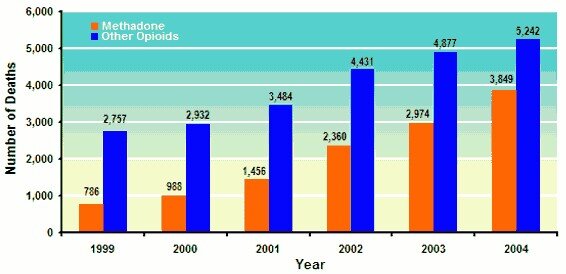David Baxter PhD
Late Founder
Report Details Surge in Methadone Deaths
Thursday, December 06, 2007
A report released yesterday by the National Drug Intelligence Center has revealed unsettling information about the number of methadone overdoses in America. Between 1999 and 2004, the rate of methadone overdoses increased by 390 percent, with 3,849 people dying in 2004 alone. Teens and young adults aged 15 to 24 had the highest rates of death, and most deaths occurred when the individual took methadone in combination with other drugs or alcohol. The amount of methadone being prescribed by physicians has also increased, jumping 715% percent from 2001 to 2006.
Methadone has been used as a painkiller in the U.S. since the 1940s, and it is also used to alleviate withdrawal symptoms and diminish cravings in recovering heroin addicts. Recent increases in methadone prescriptions have occurred for a number of reasons. Methadone is cheaper than other opioids and can be taken less frequently, making it a cost-effective way to treat pain. In 2001, the amount of methadone shipped to hospitals, pharmacies, and doctors' offices was 1.9 million grams, but by 2006 that number had risen to 6.6 million grams. Many physicians are now turning to methadone first when treating a patient's pain, especially as the number of people abusing other pain killers, notably OxyContin, has also increased. Because methadone is now more available, more people are selling their medication to recreational users, and methadone theft is also common.
Although most deaths were the result of intentional misuse, accidental misuse has also claimed lives. In these cases, patients may not have been fully cautioned about the risk factors involved in not taking the medication as directed. The report describes methadone as a "complicated" drug in terms of side effects and dosing, which is why some physicians believe methadone should be used only after other pain killers have been tried. Methadone metabolizes slowly, staying in the body for 8 to 59 hours after it is taken. Because pain relief lasts only 4 to 8 hours, some patients take more than is recommended or up their dosage, not realizing that toxic levels of the drug can build up quickly.
Although the number of overdoses from all other opioids remains higher than the number of overdoses from methadone alone, methadone overdose rates have risen faster than the rate for any other opioid. The report emphasizes that physicians and patients need to be vigilant about the possible dangers of this medication:
Thursday, December 06, 2007
A report released yesterday by the National Drug Intelligence Center has revealed unsettling information about the number of methadone overdoses in America. Between 1999 and 2004, the rate of methadone overdoses increased by 390 percent, with 3,849 people dying in 2004 alone. Teens and young adults aged 15 to 24 had the highest rates of death, and most deaths occurred when the individual took methadone in combination with other drugs or alcohol. The amount of methadone being prescribed by physicians has also increased, jumping 715% percent from 2001 to 2006.
Methadone has been used as a painkiller in the U.S. since the 1940s, and it is also used to alleviate withdrawal symptoms and diminish cravings in recovering heroin addicts. Recent increases in methadone prescriptions have occurred for a number of reasons. Methadone is cheaper than other opioids and can be taken less frequently, making it a cost-effective way to treat pain. In 2001, the amount of methadone shipped to hospitals, pharmacies, and doctors' offices was 1.9 million grams, but by 2006 that number had risen to 6.6 million grams. Many physicians are now turning to methadone first when treating a patient's pain, especially as the number of people abusing other pain killers, notably OxyContin, has also increased. Because methadone is now more available, more people are selling their medication to recreational users, and methadone theft is also common.
Although most deaths were the result of intentional misuse, accidental misuse has also claimed lives. In these cases, patients may not have been fully cautioned about the risk factors involved in not taking the medication as directed. The report describes methadone as a "complicated" drug in terms of side effects and dosing, which is why some physicians believe methadone should be used only after other pain killers have been tried. Methadone metabolizes slowly, staying in the body for 8 to 59 hours after it is taken. Because pain relief lasts only 4 to 8 hours, some patients take more than is recommended or up their dosage, not realizing that toxic levels of the drug can build up quickly.
Although the number of overdoses from all other opioids remains higher than the number of overdoses from methadone alone, methadone overdose rates have risen faster than the rate for any other opioid. The report emphasizes that physicians and patients need to be vigilant about the possible dangers of this medication:
"Methadone is a safe and effective drug when used as prescribed; however, patients who are prescribed methadone need to be monitored by a physician well trained in the pharmacodynamic and pharmacokinetic properties of the drug, particularly if the patients have no prior history of opioid use for pain management."
The report provides some suggestions for ensuring these trends do not continue, including preventative programs targeting those most at risk for methadone abuse. As more people become aware of the number of deaths among methadone users, and the problem of prescription drug abuse in general, we will hopefully see a decrease in the number of deaths associated with these medications. 
